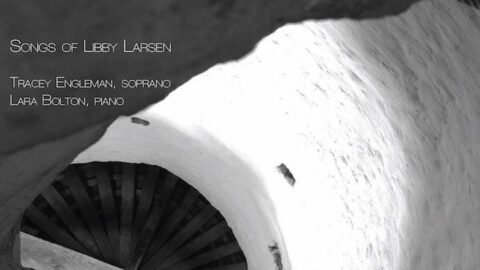Tracey Engleman and Lara Bolton’s Lift Me Into Heaven Slowly (Innova Recordings) takes you on a journey into four different worlds. The four song cycles by American composer Libby Larsen—an advocate for and champion of new music as well as the co-founder of the American Composers Forum—function as a collection of short stories, each with its own specific narrative and set of characters. Larsen writes American songs with a modern flair: soaring and operatic melodies with angular and lilting rhythmic figures sit above a clear harmonic language. Engelman and Bolton bring these historic worlds to life and add a sincerity and directness to Larsen’s songs that make each vignette, though universal in application, speak on an individual scale.
The album opens with Cowboy Songs, immediately transporting us to the Wild West. The Americana sounding “Bucking Bronco” and “Billy the Kid” make up the bookends of this short set, with the middle movement, “Lift Me Into Heaven Slowly,” providing a quiet repose. Larsen’s depiction of the American West—the bucking bronco’s liveliness and the folk legend Billy the Kid’s pulsing ferocity—seems to come out of Copland’s world. The liner notes lack the text, but Engleman makes up for this by delivering every sentence with the utmost precision. The title track is easily the most intimate and direct song on the album. In what is otherwise a heavily dramatic performance overall, “Lift Me Into Heaven Slowly” allows for soft simplicity to shine. The descending triadic melody is tinged with bluesy inflections, yet the harmonic structure feels largely classical. Engleman’s soulful delivery, with minimal vibrato, could have been incorporated for a wider variety of texture and timbre at other points throughout the album.

From the Wild West, we don’t have to travel far to get to the world of Songs From Letters, Calamity Jane to her daughter Janey, 1880-1902. Martha Jane Canary Hickock, known as Calamity Jane, was a woman at odds with her 19th century existence. She rejected a maternal lifestyle in favor of the working world, supporting herself as a gambler, prostitute, and performer. These five songs oscillate between remorse and pride. “He Never Misses” is driven by an incessant rhythmic figure that becomes heavily accented and dissonant, adding a sense of mania, contrasted with “All I Have,” which gives voice to Calamity Jane’s sorrow through deep anguish-filled sighs. Here, Larsen showcases her ability to craft long melodic arcs, sung with earnestness and clarity. Despite any feelings of animosity we might feel toward Calamity Jane for abandoning her daughter, the most successful moments are the ones of tenderness, as she wallows in her own faults and asks for forgiveness, proving she too felt deep regret.
The third song cycle, My Ántonia, based on Willa Cather’s iconic novel, is the most musically cohesive narrative. We enter and depart the prairie of Nebraska by train, in between learning the story of Jim and his time spent with Ántonia. The piano sets the backdrop of the prairie landscape and frontier life through the chugging along of the train, the blustery winter winds, the brightness of springtime, and a folk-infused waltz. “Ántonia in the Field” opens with Bolton’s lyrical voicing of a spare and sustained piano line, as gently rocking chords evoke a traditionally Romantic art song. A repeated “Ántonia” motif adds to the cohesiveness throughout the cycle, with Engleman’s voice soaring in this leaping figure. Engleman’s finest moment comes in “Landscape II: Winter,” when she sings “Winter lies too long in country towns” and “Like the light of truth itself” completely devoid of vibrato, the most dramatic change in timbre on the entire album.

Try Me Good King: Last Words of the Wives of Henry VIII transports us out of the American world of the previous three cycles to the Tudor Monarchy. These texts, drawn from the final words of five of Henry VIII’s six wives, depict women who are exasperated, fearful, anguished, and sorrowful. The liner notes describe Larsen’s inspiration: “In these songs, I chose to focus on the intimate crises of the heart. This group of songs is a monodrama of anguish and power.” Underneath these highly operatic lines, Larsen weaves in lute songs by Elizabethan composers Dowland, Campion, and Praetorius. “Anne Boleyn” opens with punchy piano figures over which frenetic interjections utilize Engleman’s vocal range. Though the Elizabethan elements appear in a calm middle section with slow and rolled piano chords, the dramatic vocalisms return even stronger than before. A macabre recitative ends the song as Anne Boleyn awaits her execution, saying, “I hope the executioner is good, and my neck is so little.”
Throughout the journey of Lift Me Into Heaven Slowly, Engleman and Bolton provide excellent realizations of character within four distinct worlds. While the performance is technically precise and delivered with clarity, the highly controlled recording environment and the dramatic delivery does not always allow for the depth of color so inherent in art songs. Engleman’s rich, vibrato-heavy sound shines as she ascends to great heights and makes text speak clearly, but a more intimate atmosphere rarely comes through. Engleman and Bolton’s nuanced performance, however, allows us to experience the universal emotions while still retaining specificity. Ultimately, Lift Me Into Heaven Slowly is a journey worth taking.
























